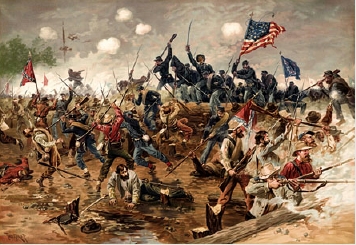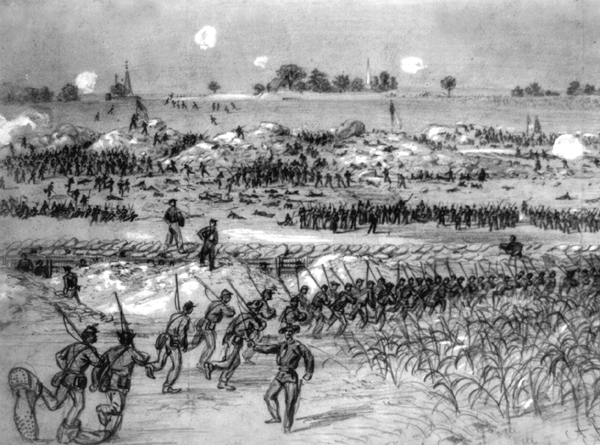Public domain map from the National Park Service |
Anson
Croman and the 20th Michigan in the IXth Corps served in
the Overland Campaign from its start on May 4, 1864.
Most of the Union
forces in the Army of the Potomac were under the command
of General Meade,. The IXth Corps and 20th Michigan were commanded
by General Burnside under General Grant. The Union forces
crossed the Rappahannock River and engaged the
Confederate army in almost continuous fighting. |
 |
Union assault on the Angle, Spotsylvania, Virginia, mid-May 1864. The IXth Corps and the 20th Michigan were just on the edge of the area illustrated in this scene. One historian states this is one of the most accurate depictions of Civil War combat. |
When previous Union commanders
suffered a setback in operations between Washington and
Richmond, they withdrew into defensive positions behind a
river,
When General Grant suffered a stalemate or was defeated during
the Overland Campaign, he held his position then resumed his
advance towards Richmond with a goal of forcing the
Confederates to risk their forces defending their capitol. General Grant followed President Lincoln’s instructions
to make his goal the defeat of the Confederate army and not
the capture of their capitol.
Crossing the James River
Therefore
in June, instead of making frontal assaults against the
heavily defended Confederate capitol of Richmond, General
Grant and the 20th Michigan outflanked the Confederates
by crossing the James River south of Richmond and attacking
the rail but of Petersburg, Virginia south of Richmond.
Siege
of Petersburg
On about June 18th, after
failing to capture Petersburg by assault Generals Grant and
Meade switched to siege tactics.
Battle
of the Crater
On July 30, 1864, the IXth Corps exploded a mine under the Confederate trenches just east of Petersburg. The 20th Michigan took part in the attack, known as the Battle of the Crater. The Confederates held and quickly closed the gap created by the explosion.
 |
The opening scene of the novel and the movie “Cold Mountain” are set in the Battle of the Crater. The 20th Michigan was on the edge of what was depicted. |
 |
| Position of the 20th Michigan
and the Crater From: The Battle Atlas of the Civil War by the editors of © Time-Life Books |
 |
Depiction of Union assault after the
explosion of the mine. The 20th Michigan was to the
left of this scene. Public domain image. |
After the Union defeat, the IXth Corps with the 20th Michigan joined attempts to break through Confederate lines and capture Confederate railroad lines south and west of Petersburg.
Sections of railroad lines were captured but the Union was unable to break through. However, they forced the Confederates to stretch their few and decreasing forces further south and west to block the Union armies.
Afterward,
the 20th Michigan and the IXth returned to their
positions east of Petersburg south of the Appomattox River
| INDEX: Anson Croman and the American Civil War | ||
|
INDEX: Cizewski, Lovetere,
Musbach, & Robinson Families History |
|
|